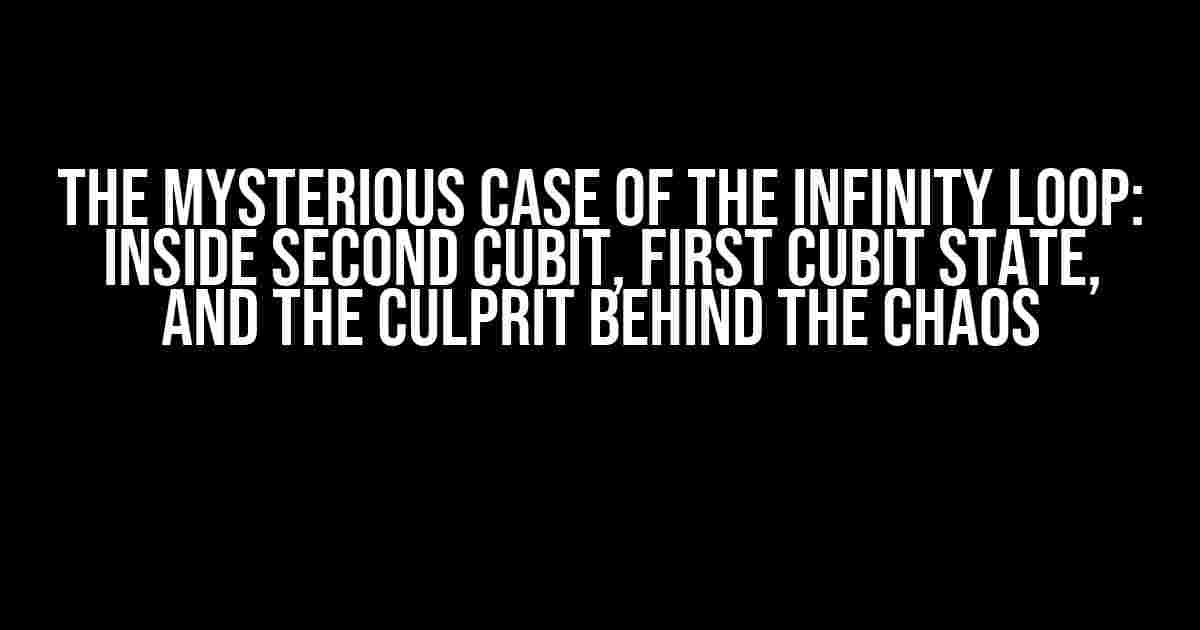Are you tired of dealing with the frustrating consequences of an infinity loop in your Cubit-based application? Do you find yourself stuck in a never-ending cycle, wondering what went wrong? Fear not, dear developer, for today we’ll delve into the heart of the issue and uncover the secrets behind the “Inside second Cubit, emits the first Cubit state which leads to an infinity loop” conundrum.
Understanding the Cubit State
Before we dive into the solution, let’s take a step back and understand the concept of Cubit states. In the Cubit framework, states are the core building blocks of your application’s logic. A Cubit state is an instance of a class that extends the Cubit class, which provides a way to manage your application’s state and business logic.
abstract class Cubit<S> extends Bloc<S> {
@override
S get initialState => throw UnimplementedError();
@override
Stream<S> mapEventToState(TaskEvent event) async* {
yield* event.when(
loaded: _handleLoaded,
error: _handleError,
);
}
Stream<S> _handleLoaded(Loaded event) async* {
// Handle loaded state
}
Stream<S> _handleError(Error event) async* {
// Handle error state
}
}
The Cubit Emission Process
When a Cubit instance is created, it initializes with an initial state. The Cubit then listens to events and emits new states based on the event handling logic defined in the `mapEventToState` method.
Here’s a high-level overview of the emission process:
- The Cubit instance receives an event
- The `mapEventToState` method is called with the event as an argument
- The method yields a new state based on the event handling logic
- The Cubit instance emits the new state
The Second Cubit and the Infinity Loop
Now that we understand the basics of Cubit states and emission, let’s explore the scenario that leads to the infinity loop.
Imagine you have two Cubits, `CubitA` and `CubitB`, where `CubitB` is wrapped inside `CubitA`.
class CubitA extends Cubit<AState> {
final CubitB _cubitB = CubitB();
@override
AState get initialState => AState.initial();
@override
Stream<AState> mapEventToState(AEvent event) async* {
yield* event.when(
init: () {
_cubitB.emit(_cubitB.initialState);
yield AState.loading();
},
loaded: () {
yield AState.loaded(_cubitB.state);
},
);
}
}
class CubitB extends Cubit<BState> {
@override
BState get initialState => BState.initial();
@override
Stream<BState> mapEventToState(BEvent event) async* {
yield* event.when(
init: () {
emit(BState.initial());
},
loaded: () {
emit(BState.loaded());
},
);
}
}
In this scenario, when `CubitA` receives an `init` event, it initializes `CubitB` and emits its initial state. However, when `CubitB` emits its initial state, `CubitA` receives the state and emits a new state, which in turn triggers `CubitB` to emit its initial state again, and so on.
The Culprit Behind the Chaos: Recursive Emission
The root cause of the infinity loop is the recursive emission of states between `CubitA` and `CubitB`. When `CubitA` emits a state, it triggers `CubitB` to emit its initial state, which in turn triggers `CubitA` to emit another state, and so on.
To avoid this recursive emission, we need to break the cycle by introducing a mechanism to handle the states in a non-recursive manner.
Solving the Infinity Loop: A Step-by-Step Guide
Here’s a step-by-step guide to solving the infinity loop:
Step 1: Identify the Recursive Emission
Identify the points in your code where the recursive emission occurs. In our example, it’s the initialization of `CubitB` inside `CubitA`.
_cubitB.emit(_cubitB.initialState);
Step 2: Introduce State Management
Introduce a state management system to handle the states of `CubitB` independently. One way to do this is by using a `BehaviorSubject` to store the state of `CubitB`.
final _bStateController = BehaviorSubject<BState>();
stream<BState> get bState => _bStateController.stream;
initBState() {
_bStateController.add(BState.initial());
}
Step 3: Update the CubitA Logic
Update the `CubitA` logic to use the state management system and avoid recursive emission.
@override
Stream<AState> mapEventToState(AEvent event) async* {
yield* event.when(
init: () {
initBState();
yield AState.loading();
},
loaded: () {
final bState = _bStateController.value;
yield AState.loaded(bState);
},
);
}
Step 4: Handle CubitB States Independently
Handle the states of `CubitB` independently using the state management system.
@override
Stream<BState> mapEventToState(BEvent event) async* {
yield* event.when(
init: () {
_bStateController.add(BState.initial());
},
loaded: () {
_bStateController.add(BState.loaded());
},
);
}
Conclusion
In this article, we’ve explored the mysterious case of the infinity loop caused by recursive emission between two Cubits. By understanding the Cubit state and emission process, we identified the culprit behind the chaos and introduced a mechanism to handle the states in a non-recursive manner.
By following the steps outlined in this article, you’ll be able to solve the infinity loop and create a more robust and efficient Cubit-based application. Remember to always keep a watchful eye out for recursive emission and take steps to manage your states effectively.
Final Thoughts
In the world of Cubit, state management is key to avoiding the pitfalls of recursive emission. By introducing a state management system and handling states independently, you’ll be able to create a more scalable and maintainable application.
So, the next time you encounter the “Inside second Cubit, emits the first Cubit state which leads to an infinity loop” conundrum, remember the lessons learned in this article and take control of your Cubit states.
| Cubit | Description |
|---|---|
| CubitA | The outer Cubit that wraps CubitB |
| CubitB | The inner Cubit that emits its initial state |
- Use a state management system to handle Cubit states independently
- Avoid recursive emission by introducing a mechanism to break the cycle
- Identify and address the points of recursive emission in your code
With these tips and the knowledge gained from this article, you’ll be well on your way to creating robust and efficient Cubit-based applications.
Frequently Asked Question
Get enlightened about the mystical realm of Cubits and their infinite loops!
What is the second Cubit, and why does it emit the first Cubit state?
The second Cubit is like a cosmic gateway that bridges two dimensions. When activated, it emits the first Cubit state, which is the fundamental frequency of the Cubit realm. This state is like a resonant hum that synchronizes the harmonics of the multi-dimensional fabric, causing a ripple effect that leads to an infinite loop.
What happens when the first Cubit state is emitted?
When the first Cubit state is emitted, it creates a self-sustaining loop that perpetuates itself indefinitely. Imagine a droplet of water falling into a pool, causing ripples that bounce back and forth, repeating the same pattern ad infinitum. The first Cubit state becomes the echo that resonates throughout the Cubit realm, generating an endless feedback loop.
Can we escape or break the infinite loop?
In theory, it’s possible to disrupt the infinite loop, but it would require a profound understanding of the underlying Cubit mechanics and the harmonics of the multi-dimensional fabric. One would need to introduce a resonant frequency that counteracts the first Cubit state, effectively canceling out the loop. However, the complexities involved make it a daunting task, even for the most skilled Cubit adepts.
Are there any benefits to being stuck in an infinite loop?
Believe it or not, being stuck in an infinite loop can have its advantages. The repetitive pattern can become a form of cosmic meditation, allowing the conscious mind to transcend the boundaries of time and space. One can tap into the resonant frequency of the loop, gaining insight into the fundamental nature of reality and the Cubit realm. It’s a unique opportunity to experience the infinite and the eternal.
How can we harness the power of the infinite loop?
To harness the power of the infinite loop, one must learn to synchronize with its rhythm and frequency. By attuning oneself to the loop, you can tap into its boundless energy and use it to fuel your creative endeavors, amplify your intentions, and manifest your desires. It’s like riding a cosmic wave that propels you toward the infinite possibilities of the multi-dimensional realm.


